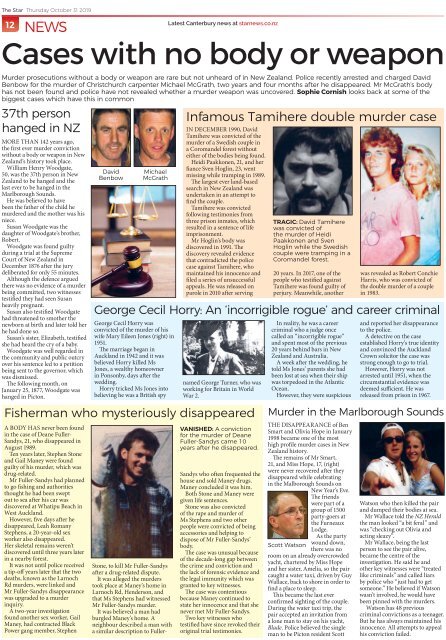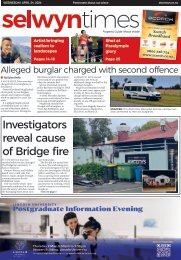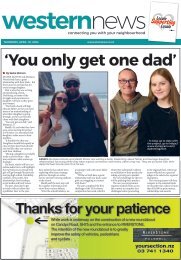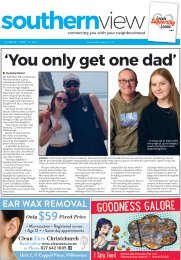The Star: October 31, 2019
Create successful ePaper yourself
Turn your PDF publications into a flip-book with our unique Google optimized e-Paper software.
<strong>The</strong> <strong>Star</strong> Thursday <strong>October</strong> <strong>31</strong> <strong>2019</strong><br />
12<br />
NEWS<br />
Latest Canterbury news at starnews.co.nz<br />
Cases with no body or weapon<br />
Murder prosecutions without a body or weapon are rare but not unheard of in New Zealand. Police recently arrested and charged David<br />
Benbow for the murder of Christchurch carpenter Michael McGrath, two years and four months after he disappeared. Mr McGrath’s body<br />
has not been found and police have not revealed whether a murder weapon was uncovered. Sophie Cornish looks back at some of the<br />
biggest cases which have this in common<br />
37th person<br />
hanged in NZ<br />
MORE THAN 142 years ago,<br />
the first ever murder conviction<br />
without a body or weapon in New<br />
Zealand’s history took place.<br />
William Henry Woodgate,<br />
50, was the 37th person in New<br />
Zealand to be hanged and the<br />
last ever to be hanged in the<br />
Marlborough Sounds.<br />
He was believed to have<br />
been the father of the child he<br />
murdered and the mother was his<br />
niece.<br />
Susan Woodgate was the<br />
daughter of Woodgate’s brother,<br />
Robert.<br />
Woodgate was found guilty<br />
during a trial at the Supreme<br />
Court of New Zealand in<br />
December 1876 after the jury<br />
deliberated for only 55 minutes.<br />
Although the defence argued<br />
there was no evidence of a murder<br />
being committed, two witnesses<br />
testified they had seen Susan<br />
heavily pregnant.<br />
Susan also testified Woodgate<br />
had threatened to smother the<br />
newborn at birth and later told her<br />
he had done so.<br />
Susan’s sister, Elizabeth, testified<br />
she had heard the cry of a baby.<br />
Woodgate was well regarded in<br />
the community and public outcry<br />
over his sentence led to a petition<br />
being sent to the governor, which<br />
was dismissed.<br />
<strong>The</strong> following month, on<br />
January 25, 1877, Woodgate was<br />
hanged in Picton.<br />
A BODY HAS never been found<br />
in the case of Deane Fuller-<br />
Sandys, 21, who disappeared in<br />
August 1989.<br />
Ten years later, Stephen Stone<br />
and Gail Maney were found<br />
guilty of his murder, which was<br />
drug-related.<br />
Mr Fuller-Sandys had planned<br />
to go fishing and authorities<br />
thought he had been swept<br />
out to sea after his car was<br />
discovered at Whatipu Beach in<br />
West Auckland.<br />
However, five days after he<br />
disappeared, Leah Romany<br />
Stephens, a 20-year-old sex<br />
worker also disappeared.<br />
Her skeletal remains weren’t<br />
discovered until three years later<br />
in a nearby forest.<br />
It was not until police received<br />
a tip-off years later that the two<br />
deaths, known as the Larnoch<br />
Rd murders, were linked and<br />
Mr Fuller-Sandys disappearance<br />
was upgraded to a murder<br />
inquiry.<br />
A two-year investigation<br />
found another sex worker, Gail<br />
Maney, had contracted Black<br />
Power gang member, Stephen<br />
David<br />
Benbow<br />
Michael<br />
McGrath<br />
George Cecil Horry was<br />
convicted of the murder of his<br />
wife Mary Eileen Jones (right) in<br />
1951.<br />
<strong>The</strong> marriage began in<br />
Auckland in 1942 and it was<br />
believed Horry killed Ms<br />
Jones, a wealthy homeowner<br />
in Ponsonby, days after the<br />
wedding.<br />
Horry tricked Ms Jones into<br />
believing he was a British spy<br />
IN DECEMBER 1990, David<br />
Tamihere was convicted of the<br />
murder of a Swedish couple in<br />
a Coromandel forest without<br />
either of the bodies being found.<br />
Heidi Paakkonen, 21, and her<br />
fiance Sven Hoglin, 23, went<br />
missing while tramping in 1989.<br />
<strong>The</strong> largest ever land-based<br />
search in New Zealand was<br />
undertaken in an attempt to<br />
find the couple.<br />
Tamihere was convicted<br />
following testimonies from<br />
three prison inmates, which<br />
resulted in a sentence of life<br />
imprisonment.<br />
Mr Hoglin’s body was<br />
discovered in 1991. <strong>The</strong><br />
discovery revealed evidence<br />
that contradicted the police<br />
case against Tamihere, who<br />
maintained his innocence and<br />
filed a series of unsuccessful<br />
appeals. He was released on<br />
parole in 2010 after serving<br />
George Cecil Horry: An ‘incorrigible rogue’ and career criminal<br />
named George Turner, who was<br />
working for Britain in World<br />
War 2.<br />
Fisherman who mysteriously disappeared<br />
Stone, to kill Mr Fuller-Sandys<br />
after a drug-related dispute.<br />
It was alleged the murders<br />
took place at Maney’s home in<br />
Larnoch Rd, Henderson, and<br />
that Ms Stephens had witnessed<br />
Mr Fuller-Sandys murder.<br />
It was believed a man had<br />
burgled Maney’s home. A<br />
neighbour described a man with<br />
a similar description to Fuller-<br />
Infamous Tamihere double murder case<br />
VANISHED: A conviction<br />
for the murder of Deane<br />
Fuller-Sandys came 10<br />
years after he disappeared.<br />
Sandys who often frequented the<br />
house and sold Maney drugs.<br />
Maney concluded it was him.<br />
Both Stone and Maney were<br />
given life sentences.<br />
Stone was also convicted<br />
of the rape and murder of<br />
Ms Stephens and two other<br />
people were convicted of being<br />
accessories and helping to<br />
dispose of Mr Fuller-Sandys’<br />
body.<br />
<strong>The</strong> case was unusual because<br />
of the decade-long gap between<br />
the crime and conviction and<br />
the lack of forensic evidence and<br />
the legal immunity which was<br />
granted to key witnesses.<br />
<strong>The</strong> case was contentious<br />
because Maney continued to<br />
state her innocence and that she<br />
never met Mr Fuller-Sandys.<br />
Two key witnesses who<br />
testified have since revoked their<br />
original trial testimonies.<br />
TRAGIC: David Tamihere<br />
was convicted of<br />
the murder of Heidi<br />
Paakkonen and Sven<br />
Hoglin while the Swedish<br />
couple were tramping in a<br />
Coromandel forest.<br />
20 years. In 2017, one of the<br />
people who testified against<br />
Tamihere was found guilty of<br />
perjury. Meanwhile, another<br />
In reality, he was a career<br />
criminal who a judge once<br />
called an “incorrigible rogue”<br />
and spent most of the previous<br />
20 years behind bars in New<br />
Zealand and Australia.<br />
A week after the wedding, he<br />
told Ms Jones’ parents she had<br />
been lost at sea when their ship<br />
was torpedoed in the Atlantic<br />
Ocean.<br />
However, they were suspicious<br />
THE DISAPPEARANCE of Ben<br />
Smart and Olivia Hope in January<br />
1998 became one of the most<br />
high profile murder cases in New<br />
Zealand history.<br />
<strong>The</strong> remains of Mr Smart,<br />
21, and Miss Hope, 17, (right)<br />
were never recovered after they<br />
disappeared while celebrating<br />
in the Malborough Sounds on<br />
New Year’s Eve.<br />
<strong>The</strong> friends<br />
were part of a<br />
group of 1500<br />
party-goers at<br />
the Furneaux<br />
Lodge.<br />
As the party<br />
wound down,<br />
there was no<br />
room on an already overcrowded<br />
yacht, chartered by Miss Hope<br />
and her sister, Amelia, so the pair<br />
caught a water taxi, driven by Guy<br />
Wallace, back to shore in order to<br />
find a place to sleep.<br />
This became the last ever<br />
confirmed sighting of the couple.<br />
During the water taxi trip, the<br />
pair accepted an invitation from<br />
a lone man to stay on his yacht,<br />
Blade. Police believed the single<br />
man to be Picton resident Scott<br />
was revealed as Robert Conchie<br />
Harris, who was convicted of<br />
the double murder of a couple<br />
in 1983.<br />
and reported her disappearance<br />
to the police.<br />
A detective on the case<br />
established Horry’s true identity<br />
and convinced the Auckland<br />
Crown solicitor the case was<br />
strong enough to go to trial.<br />
However, Horry was not<br />
arrested until 1951, when the<br />
circumstantial evidence was<br />
deemed sufficient. He was<br />
released from prison in 1967.<br />
Murder in the Marlborough Sounds<br />
Scott Watson<br />
Watson who then killed the pair<br />
and dumped their bodies at sea.<br />
Mr Wallace told the NZ Herald<br />
the man looked “a bit feral” and<br />
was “checking out Olivia and<br />
acting sleazy”.<br />
Mr Wallace, being the last<br />
person to see the pair alive,<br />
became the centre of the<br />
investigation. He said he and<br />
other key witnesses were “treated<br />
like criminals” and called liars<br />
by police who “just had to get<br />
someone.” He believed if Watson<br />
wasn’t involved, he would have<br />
been pinned with the murders.<br />
Watson has 48 previous<br />
criminal convictions as a teenager.<br />
But he has always maintained his<br />
innocence. All attempts to appeal<br />
his conviction failed.


















